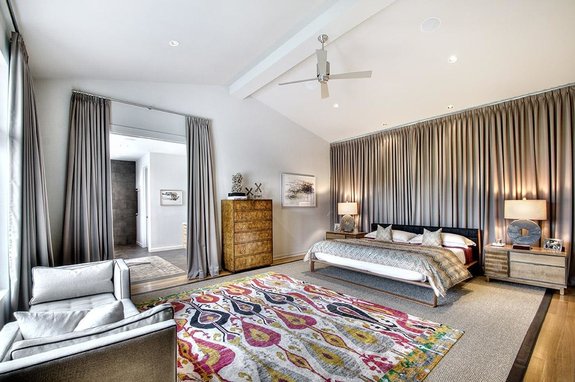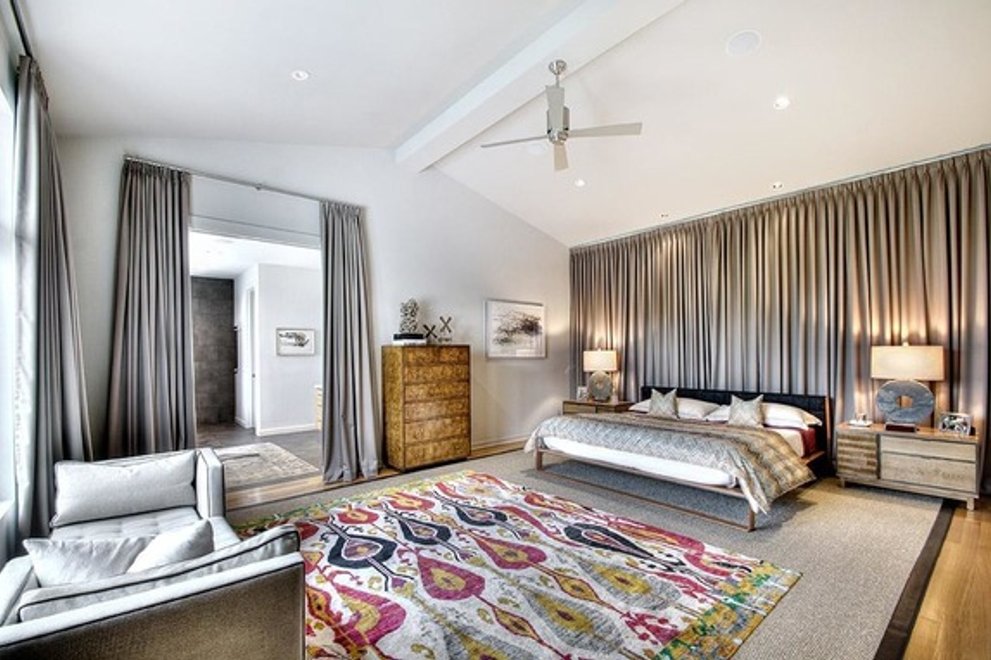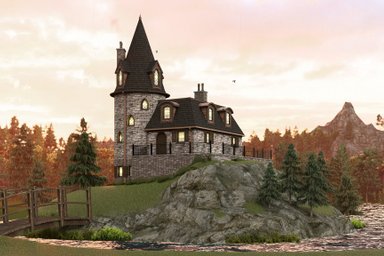By Boyce Thomspon
Outside the kitchen, the room that turns the most shoppers into buyers is the master bedroom, or “owner’s suite” as it’s often called in marketing material. The best masters register a strong romantic appeal. It’s easy to imagine them as sanctuaries; they offer the promise of relaxation and a good night’s sleep. The best masters make the most of outdoor views. They often connect to balconies and porches.
Click here to see our collection of master bedroom plans.
 That’s the case with this plan (plan935-4). It offers several opportunities for peaceful retreat.
That’s the case with this plan (plan935-4). It offers several opportunities for peaceful retreat.
What people hope to achieve with a master bedroom varies by time of life. Singles may not need a big master; they may want to reserve floor space for a guest bedroom with its own bath. For young families, the master’s proximity to children’s bedrooms may be an overriding concern. Couples with teenage children, on the other hand, may prefer to sleep in a separate wing; their children may feel the same way.
This family-oriented contemporary plan (pictured below) puts all the bedrooms on the second floor, where they are served by a game room that would be an ideal homework space. It’s easy to imagine an infant sliding into the bedroom closest to master. A vaulted ceiling and closet big enough to hold a crib, if need be, makes the master a special and practical space.
 Plan 449-13 features a vaulted master suite.
Plan 449-13 features a vaulted master suite.
Many people go into a house-plan purchase decision thinking they want the master bedroom either up or down. A first-floor master is a given in many parts of the country, particularly the Southwest, where ranch plans rule. In other regions, the decision may be dictated by cost, age, or mobility. In the Northeast, for instance, it may be tough to afford a big enough lot to support a plan with a master down. You may have to sacrifice too much public space on the first floor to make it happen. There’s something to be gained, though, from climbing stairs – it’s a great form of exercise.
Another advantage to a second-floor bedroom: If your home has multiple zones for heating and air conditioning, you can just turn off the second floor during the day. Some people feel that second-floor bedrooms are more secure in the event of a break-in. That said, a second-floor master is a non-starter for people who can’t climb stairs. The good news is that as the population ages designers are getting better at finding ways to squeeze a master in the first floor without forcing too many other sacrifices. Here’s a great example of a wide, family-oriented plan (pictured below) with a first-floor master suite complete with a fireplace and a sitting area by the window.
The biggest trend in master bedrooms is the way the room has morphed into a get-away space. Even in 2,600-square-foot plans, it’s common to see sitting areas within the master to watch TV, read a book, or just relax. The addition of coffee makers and wine chillers makes the master an even better place to relax in the morning and evening. Even better if the bedroom is connected to a private patio or balcony so that you can slip outside undetected. In the most luxurious house plans, the master suite may rival a suite in a five-star hotel. As in many luxury home plans, a vestibule marks the entry to the master bedroom. A short hallway raises expectations of what’s inside even as it creates privacy. The suite delivers on the promise of elegance with vaulted ceilings, a brick fireplace and TV walls, and a private patio. A second vestibule – this one leading to the master bath bathroom – accommodates large walk-in closets, an obligatory element in a luxury home. And all this is located on the first floor, far removed from secondary bedrooms and a laundry room upstairs. Each bedroom in the plan is served by its own bath, another given in luxury homes.
In tighter plans without space for a vestibule, the privacy of the master needs to be addressed in other ways. After all, you don’t want visitors looking into your bedroom from the front door or public rooms of the house, just in case you didn’t make the bed, or you left clothes draped over furniture. The master suite in this plan (below) is tucked around the corner from public rooms. Visitors may not even know it’s there. Yet it’s large. It runs from the front to back of the house and features a private sitting bay with its own deck access.
 Plan 927-5
Plan 927-5
Another advantage of this master is that it reserves space for clothes and linen storage. It’s nice if you don’t have to carry dry-cleaning very far from the garage. Same goes for laundry. Some plans purposely locate the laundry close to master closets so that it’s easy to store clothes and linens.
Another practical concern with the master bedroom is identifying the bed wall. You not only need enough wall space for one or two beds, but the beds need to be oriented to take advantage of exterior views. There needs to be enough space for side tables and bureaus, too. Another important concern is where the TV would go. It needs to be visible from the bed and the nook. And the screen can’t be overwhelmed by glare from windows. The pictures that often accompany a plan can be a big help when it comes to furnishing a room. It’s easy to imagine how the master would be furnished in this plan by Visbeen Architects (below).
 Plan 928-13
Plan 928-13
Bedrooms aren’t just for sleeping or relaxing, of course; they are also for dressing. The size and location of closets is important to the success of a master bedroom. Home buyers rarely complain that they have too much closet space, but the opposite is heard quite often. Even modest home designs may reserve space for separate walk-in closets in the master. But you may have a preference where they are located – the bedroom, the master bath, or someplace in between. The advantage to having master closets somewhere other than the bedroom, an increasingly popular configuration, is that one spouse can dress in the morning, or undress in the evening, without disturbing the other’s sleep.
During the housing boom, some master bedrooms got so big that they lost their human scale. Ceilings can get so high that they don’t feel like a comfortable place to sleep. The amount of floor space in the master can be disproportionate to how much time you actually spend there. Achieving this balance was the reason Frank Lloyd Wright kept bedrooms small and ceilings low. He believed they were meant for sleeping and little else. If the rest of your house is really special, you may not want to spend much time in the bedroom anyway.
Empty-nester couples may be more interested in the option of separate bedrooms rather than a huge master. This is especially true if one keeps the other awake at night. Then the issue becomes having easy access to a bathroom from the other bedroom. It’s easy to imagine a couple trading down into this comfortable single-story plan (below). One secondary bedroom is served by a near-private bath with a walk-in closet. A third bedroom could be used as an office or for guests.
Browse plans with great master bedrooms
Explore with luxurious master baths






